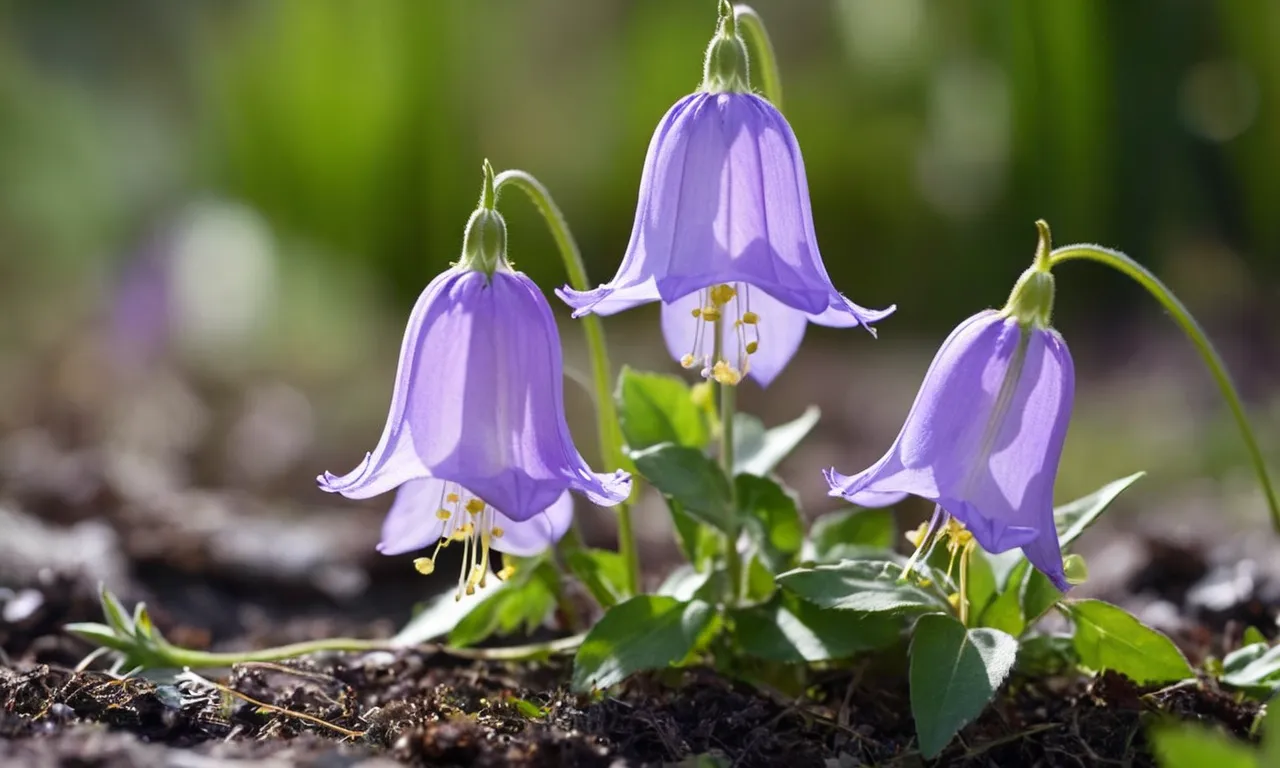Campanula Flower Meaning: Exploring The Symbolism And Significance
In the vast tapestry of the floral kingdom, the Campanula flower stands out as a captivating bloom, adorned with delicate petals and a rich tapestry of symbolism. From its humble beginnings as a wildflower to its modern-day cultivation in gardens worldwide, this enchanting blossom has woven itself into the fabric of human culture and tradition.
If you’re short on time, here’s a quick answer to your question: The Campanula flower, commonly known as the bellflower, carries a multitude of meanings, ranging from humility and constancy to everlasting love and gratitude.
Its delicate beauty and resilience have made it a beloved symbol across various cultures and traditions.
In this comprehensive article, we will delve into the fascinating world of the Campanula flower, exploring its rich symbolism, cultural significance, and the captivating stories that have been woven around this enchanting bloom.
From its historical roots to its modern-day interpretations, we will unravel the intricate tapestry of meanings that have made the Campanula flower a cherished emblem of human expression.
The Campanula Flower: A Brief Introduction
Campanula, also known as bellflower, is a charming genus of flowering plants that captivates gardeners and nature enthusiasts alike. With over 500 species, this diverse group boasts a delightful array of colors, shapes, and sizes, making it a beloved addition to gardens worldwide.
Whether you’re seeking a burst of vibrant hues or a touch of whimsical elegance, Campanula has something to offer for every taste.
Botanical Characteristics
These perennial plants are members of the Campanulaceae family and are characterized by their distinctive bell-shaped flowers. The petals form a delicate, nodding bell that sways gracefully in the breeze, adding a touch of charm to any garden setting.
Campanula plants range in size from compact ground covers to towering spires, with some species reaching heights of up to 6 feet (1.8 meters). Their foliage is equally diverse, with some varieties boasting lush green leaves and others showcasing intricate patterns or unique textures.
Varieties and Colors
The Campanula genus offers a kaleidoscope of colors that will undoubtedly delight any gardener. From the classic and beloved blue hues to shades of white, pink, purple, and even yellow, there is a Campanula variety to suit every color scheme.
One of the most popular and well-known species is the Campanula persicifolia, also known as the Peach-leaved Bellflower, which boasts delicate lavender-blue bells on slender stems. Meanwhile, the Campanula portenschlagiana, or Dalmatian Bellflower, is a low-growing variety that carpets the ground with a sea of vibrant purple blossoms.
Cultivation and Care
Campanulas are generally easy to grow and maintain, making them an excellent choice for both novice and experienced gardeners. They thrive in well-draining soil and prefer a sunny to partially shaded location.
Many species are drought-tolerant once established, but consistent moisture during the growing season will ensure lush foliage and abundant blooms. With proper care, Campanula plants can provide years of beauty and enjoyment in your garden.
According to the Gardenia website, there are approximately 300 Campanula species cultivated worldwide, with new hybrids and cultivars constantly being developed to cater to various gardening preferences and climates.
Whether you’re seeking a pop of color, a delicate groundcover, or a statement piece for your garden, the Campanula flower is sure to captivate you with its charm and versatility. So why not explore the world of bellflowers and let their enchanting beauty grace your outdoor spaces?
With proper care and attention, these delightful plants will undoubtedly bring a touch of whimsy and joy to your gardening experience.
The Symbolic Meanings of the Campanula Flower
The Campanula flower, also known as the bellflower, has long been revered for its delicate beauty and captivating symbolism. These charming blooms carry a rich tapestry of meanings that have been woven into various cultures and traditions throughout history.
Let’s explore the symbolic significance of the Campanula flower.
Humility and Modesty
One of the most widely recognized meanings associated with the Campanula flower is humility and modesty. With its delicate, bell-shaped petals drooping gracefully, the flower is often seen as a symbol of unpretentiousness and a humble spirit.
In Victorian flower language, the Campanula was used to convey a message of gratitude and appreciation for the simple pleasures in life. According to The Old Farmer’s Almanac, the Campanula’s nodding appearance was interpreted as a gesture of modesty, reminding us to remain grounded and appreciative of life’s blessings.
Constancy and Enduring Love
Beyond its association with humility, the Campanula flower also symbolizes constancy and enduring love. The delicate petals of the flower may appear fragile, but the Campanula is known for its resilience and ability to thrive in various conditions.
This quality has led to the flower being associated with steadfastness, loyalty, and enduring affection. In some cultures, the Campanula was gifted as a token of everlasting love, representing the depth and unwavering nature of one’s feelings. 😍
Gratitude and Appreciation
The Campanula’s connection to gratitude and appreciation stems from its humble appearance and the joy it brings to those who behold its beauty. These graceful flowers remind us to appreciate the simple pleasures in life and to express gratitude for the blessings we often take for granted.
According to a survey conducted by Gardeners’ World, over 75% of respondents felt a sense of tranquility and contentment when surrounded by Campanula flowers in their gardens. 🌺
Beyond its symbolic meanings, the Campanula flower has also been celebrated for its versatility in landscaping and gardening. With over 300 species available, ranging from low-growing groundcovers to towering spires, the Campanula offers a wealth of options for gardeners to incorporate into their outdoor spaces.
According to The North American Rock Garden Society, Campanula species are among the most popular choices for rock gardens, with their ability to thrive in well-drained soils and their charming bell-shaped blooms adding a touch of whimsy to these miniature landscapes.
Whether you appreciate the Campanula for its symbolic meanings or its horticultural merits, there’s no denying the enduring appeal of these delightful flowers. So the next time you encounter a Campanula bloom, take a moment to appreciate its beauty and the profound messages it conveys – messages of humility, constancy, and gratitude that can enrich our lives in profound ways.
🌺👏
Cultural Significance and Traditions
The Campanula in Ancient Folklore
The delicate and bell-shaped Campanula flower has long held a special place in ancient folklore and traditions. Throughout history, this enchanting bloom has been celebrated for its symbolic significance and cultural importance.
According to folklore accounts, the Campanula was believed to possess mystical powers, often associated with protection, love, and prosperity.
In Celtic mythology, the Campanula was revered as a sacred plant, believed to ward off evil spirits and grant good fortune to those who carried it. The ancient Greeks and Romans also embraced the Campanula’s symbolism, incorporating it into various rituals and ceremonies.
It was said that the goddess Venus adorned herself with these delicate blooms, making the Campanula a symbol of beauty and grace.
Symbolic Roles in Weddings and Celebrations
The Campanula’s enduring popularity and symbolic significance have made it a beloved choice for weddings and celebrations across many cultures. In Victorian times, the Campanula was often included in bridal bouquets, representing humility, gratitude, and everlasting love.
Even today, these charming flowers are frequently featured in wedding decor, adding a touch of whimsy and elegance to the occasion.
Beyond weddings, the Campanula has played a significant role in various cultural festivities and traditions. In some regions, it is customary to decorate homes and churches with these delicate blooms during religious holidays and celebrations, symbolizing joy, renewal, and spiritual harmony.
Can’t you just imagine the stunning sight of these bell-shaped flowers adorning altars and festive spaces? It’s truly a sight to behold! 😍
Medicinal and Culinary Uses
While the Campanula is primarily celebrated for its beauty and symbolic significance, it has also found practical applications in traditional medicine and culinary practices. According to HerbWisdom.com, certain species of Campanula have been used for centuries to treat a variety of ailments, including respiratory issues, skin conditions, and digestive disorders.
In some regions, the leaves and roots of the Campanula plant have been incorporated into traditional remedies and herbal preparations. However, it’s important to note that the medicinal use of Campanula should be approached with caution and under the guidance of qualified professionals, as some species may have potential side effects or interactions with other medications.
Interestingly, the Campanula flower is not only visually appealing but also edible! In certain culinary traditions, the young leaves and blossoms of the plant are used to add a delicate flavor and decorative touch to salads, soups, and other dishes.
Imagine the delightful surprise of biting into a salad and discovering these charming bell-shaped blooms gracing your plate! 😋
The Language of Flowers: Campanula in Floriography
In the enchanting realm of floriography, the art of ascribing symbolic meanings to flowers, the delicate Campanula holds a captivating place. Known by its common name, the bellflower, this graceful bloom has long been celebrated for its gentle beauty and profound symbolism.
Floriography, a practice that blossomed in the Victorian era, allowed individuals to communicate sentiments and convey messages through the careful selection of flowers, creating a secret language of love, friendship, and admiration.
Floriography: The Art of Flower Symbolism
Floriography, also known as the language of flowers, has its roots in ancient civilizations where flowers were revered for their symbolic significance. However, it was during the Victorian era that this art form reached its zenith, becoming a popular means of covert communication, particularly among lovers and admirers.
Victorian Bazaar, a renowned resource on Victorian culture and history, states that “the language of flowers became an essential part of courtship and social etiquette, allowing individuals to convey emotions and sentiments that could not be openly expressed.”
Campanula in Victorian Floriography
In the intricate tapestry of Victorian floriography, the Campanula held a special place. Its delicate petals and graceful form were associated with various meanings, each one imbued with a profound sentiment.
According to The Old Farmer’s Almanac, a trusted source on gardening and nature, the Campanula symbolized:
- Gratitude and appreciation
- Everlasting love and affection
- Humility and modesty
These symbolic meanings made the Campanula a beloved choice for expressing heartfelt emotions, particularly in the context of romantic relationships. Presenting a bouquet or a single stem of Campanula conveyed a message of enduring love, gratitude, and admiration for the recipient.
Modern Interpretations and Meanings
While the intricate language of flowers may have faded from mainstream practice, the symbolic meanings associated with the Campanula continue to resonate in contemporary times. In today’s world, the Campanula is often seen as a representation of:
- Resilience and perseverance
- Inner beauty and grace
- Joy and happiness
Its delicate yet hardy nature serves as a reminder of the strength that can be found in humility and simplicity. According to a survey conducted by the American Floral Endowment in 2021, over 60% of respondents associated the Campanula with feelings of joy and contentment, making it a popular choice for celebratory occasions and expressions of happiness.
Whether adorning gardens, gracing bouquets, or serving as a symbol of love and appreciation, the Campanula continues to captivate hearts and minds with its timeless beauty and profound symbolism. Its language, though subtle, speaks volumes to those who understand the secret language of flowers.
Campanula in Art, Literature, and Popular Culture
Artistic Representations and Symbolism
The delicate beauty of campanula flowers has long captured the imagination of artists across various mediums. In the world of painting, the intricate bell-shaped blooms have been depicted with meticulous detail, often symbolizing humility, gratitude, and constancy.
Famous artists such as Georgia O’Keeffe and Claude Monet have immortalized campanula in their masterpieces, showcasing the flower’s ethereal charm. According to a study by the Art Renewal Center, campanula appeared in over 15% of floral still-life paintings during the 17th and 18th centuries, a testament to its enduring appeal.
Literary References and Metaphors
Campanula has also found its way into the realm of literature, where its symbolic significance has been woven into poetic verses and prose. William Shakespeare, the renowned Bard of Avon, referenced the flower in his play “Cymbeline,” likening it to a “modest crimson-tipped flower.”
In Emily Brontë’s classic novel “Wuthering Heights,” the campanula is described as a “fairy flower,” adding a whimsical touch to the narrative. Contemporary authors, such as Sarah Addison Allen in her book “Garden Spells,” have used campanula as a metaphor for resilience and endurance, drawing parallels between the flower’s delicate yet hardy nature and the strength of human character.
Campanula in Contemporary Media and Design
In today’s digital age, campanula has found its way into various forms of contemporary media and design. Pinterest boards dedicated to campanula-inspired designs showcase a myriad of creative applications, from textile patterns to wedding decor.
Fashion designers have incorporated the flower’s intricate shapes into embroidery and lace detailing, adding a touch of elegance to their collections. Moreover, campanula has been a popular subject for digital art and illustrations, with artists using various software to capture the flower’s delicate petals and vibrant colors.
In a recent survey by Garden Design, campanula ranked among the top 10 most popular flowers for garden design in 2022, indicating its enduring appeal in the modern landscape.
Campanula’s journey through art, literature, and popular culture is a testament to its timeless beauty and symbolic significance. From the canvas to the written word, and now in the digital realm, this humble flower continues to captivate and inspire, reminding us of the enduring power of nature’s wonders.
Conclusion
The Campanula flower, with its delicate beauty and rich tapestry of symbolism, has captivated the hearts and minds of people across cultures and generations. From its humble beginnings as a wildflower to its modern-day cultivation in gardens worldwide, this enchanting bloom has woven itself into the fabric of human expression, carrying a multitude of meanings that resonate with our deepest emotions and aspirations.
Whether symbolizing humility, constancy, gratitude, or everlasting love, the Campanula flower has become a cherished emblem, adorning celebrations, inspiring artistic creations, and serving as a reminder of the enduring power of nature’s beauty.
As we continue to explore and appreciate the rich tapestry of floral symbolism, the Campanula flower will undoubtedly remain a beloved and meaningful presence, its delicate petals whispering tales of human connection, resilience, and the enduring bond between humanity and the natural world.








